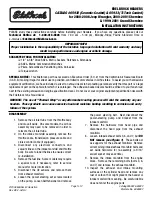
NOTE
•
Under normal driving conditions, the brake
pad will wear, and brake pad dust will
accumulate on the wheel. The wheel dust
are inevitable and will not affect the braking
performance.
•
If the brake pad and brake disc are not
used or used at a low frequency resulting in
corrosion, noise may heard at the brake
during the first use. This is normal. It is
recommended to choose a safe area and
road conditions and brake several times to
clean the brake pad and brake disc.
Brake booster
The brake booster is used to increase the
pressure applied by the driver on the brake pedal,
and it only works when the engine is running.
If the brake booster does not work properly due to
a fault, or when the car is towed, the pedal effort
must be increased to compensate for the boosting
effect of the brake booster.
WARNING
•
Do not allow the car to coast with the
engine shut down, otherwise it will
easily cause an accident! Since the
brake booster does not work at this
time, the braking distance will be greatly
increased.
•
If the brake booster does not work (for
example, when the car is being towed),
the brake pedal must be depressed with
much greater force than normal when
braking.
Braking effect and braking distance
The braking effect and braking distance are mainly
affected by the driving environment, road
conditions and driving style.
With the worn brake pad, the car cannot be
braked effectively. The wear rate of the brake pad
depends mainly on the use conditions and driving
style. If the car is often used for city driving, short-
distance driving, or as a racing car, it is
recommended to check the brake pad thickness
more frequently based on the maintenance
interval specified in the Warranty Manual.
After wading, heavy rain or car washing, the brake
pad may be wet or icy (in winter), resulting in a
reduction in braking effect. In this case, the brake
pedal must be lightly depressed to heat the brake
by friction and evaporate the water to restore the
braking effect.
133
5. Driving Guide
















































